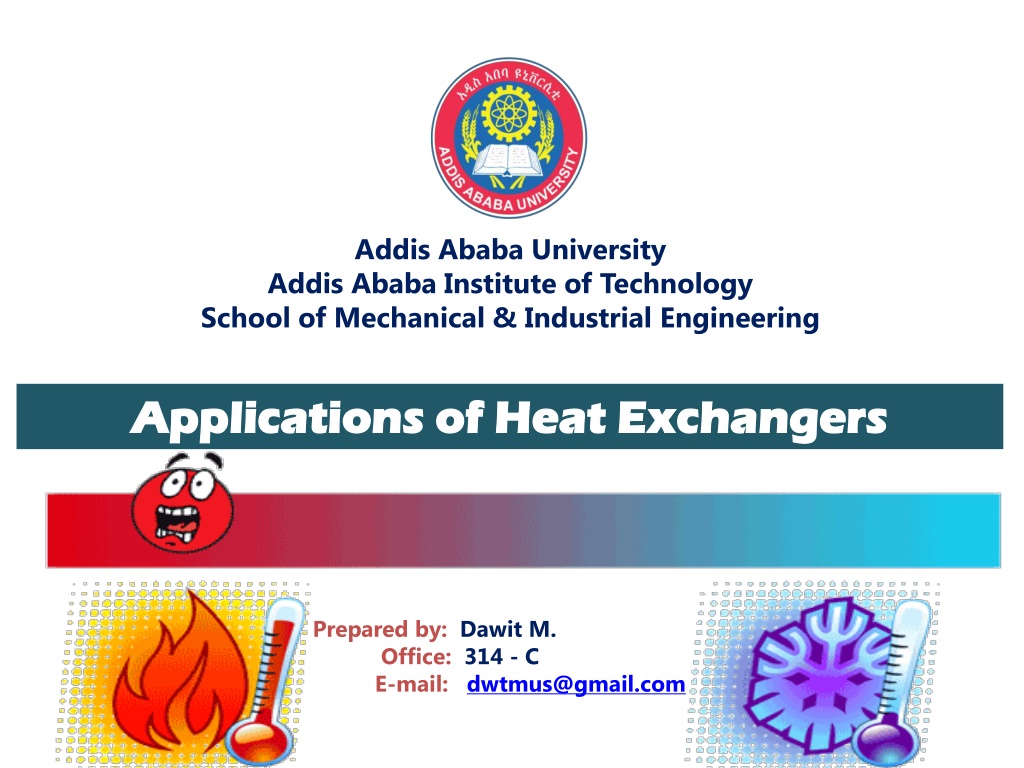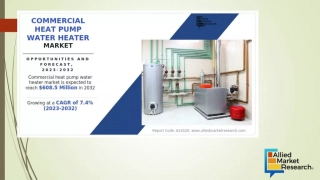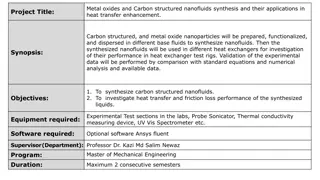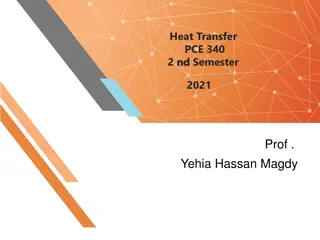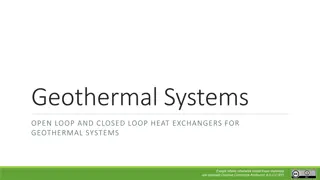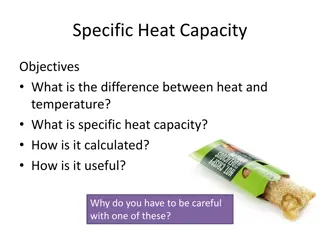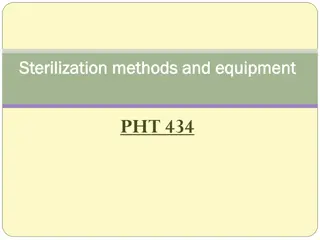Applications of Heat Exchangers in Various Industries
This topic delves into the diverse applications of heat exchangers in different industries and plants, elucidating the use of various types of heat exchange systems and their importance in processes like bio-processing, power generation, and more. The lecture covers heat exchange applications for liquid-to-liquid, liquid-to-gas, and gas-to-gas scenarios, along with the accessories and auxiliaries associated with heat exchangers. By the end, students will gain a comprehensive understanding of the different types of heat exchange systems used in various applications.
Download Presentation

Please find below an Image/Link to download the presentation.
The content on the website is provided AS IS for your information and personal use only. It may not be sold, licensed, or shared on other websites without obtaining consent from the author. Download presentation by click this link. If you encounter any issues during the download, it is possible that the publisher has removed the file from their server.
E N D
Presentation Transcript
Addis Ababa University Addis Ababa Institute of Technology School of Mechanical & Industrial Engineering Applications of Heat Exchangers Applications of Heat Exchangers Prepared by: Dawit M. Office: 314 - C E-mail: dwtmus@gmail.com
Outline o Introduction o Objectives o Heat Exchangers for Liquid to Liquid Applications Plate Heat Exchangers (Compact) Shell and Tube Heat Exchangers o Heat Exchangers for Liquid to Gas Applications Bank of Tubes in Cross Flow COLASIT Heat Exchangers Compact Heat Exchangers o Heat Exchangers for Gas to Gas Applications Compact Heat Exchangers o Applications in Thermal Power Stations and Marine Engineering o Accessories of Heat Exchangers: Anti Plugging Systems for Sea Water Anit Fouling Systems 2 AAiT School of Mechanical and Industrial Engineering - SMiE
Introduction This topic elucidates the exchangers in various process industries and plants. application of different types of heat The application of heat exchangers in bio-process, chemo- process, power generation and over a wide range, from the thermal treatment of fluids to perform cooling and heating processes, as demanded by a particular application. cogeneration industries varies Heat exchangers are also integral part of gas conditioning systems. 3 AAiT School of Mechanical and Industrial Engineering - SMiE
Objectives After completion of this lecture on heat exchangers applications, student will be able to have a good understanding on types of heat exchange systems used in: Liquid to liquid (L/L) heat exchange applications Liquid to gas (L/G) heat exchange applications Gas to gas (G/G) heat exchange applications And Auxiliaries/Accessories of heat exchangers 4 AAiT School of Mechanical and Industrial Engineering - SMiE
1. Heat Exchangers for Liquid to Liquid Applications 5 AAiT School of Mechanical and Industrial Engineering - SMiE
1.1 L/L Heat Exchange in Plate Heat Exchanger The mechanism of efficient heat transfer: Hot fluid (e.g. lub oil) and cold fluid (e.g. sea water) are flowed through four specified portholes at the four corners of each heat exchanger plate. These heat transfer made of press formed thin sheet of metal with resistance (stainless titanium). The hot fluid flows in opposite direction to the cold fluid, and heat transfer is performed plates are high corrosion steel or 6 AAiT School of Mechanical and Industrial Engineering - SMiE
Contd Features of this heat exchanger: A high heat transfer coefficient: three to five times that of tubular heat exchangers) Excellent heat transfer allows the hot fluid to be cooled close to cold fluid: even to only 10C Flexibility of heat transfer area: the number of plates can be increased or decreased according to the required duty Usable with sea water: made from corrosion resistant metals like titanium Easy to open and inspect 7 AAiT School of Mechanical and Industrial Engineering - SMiE
Contd Few station and marine engineering: applications in thermal power 1) Cooler for bearing cooling water 2) Oil cooler 3) Cooler for Stator Cooling Water Systems 8 AAiT School of Mechanical and Industrial Engineering - SMiE
Cooler for Bearing Cooling Water Application: This cooler is designed for cooling system which collects all the cooling water for every system within the entire power station/water jacket circulating water of the engine and cylinder head, and cools it with sea water as a cooling medium. Another the cooling water can be water from cooling tower or river depending on plant location. cooling medium used to cool 9 AAiT School of Mechanical and Industrial Engineering - SMiE
Contd Examples of operating conditions: It should be noted that Shell and Tube Heat Exchangers perform L/L heat exchange 10 AAiT School of Mechanical and Industrial Engineering - SMiE
Oil Cooler Application: This lubricating oil for bearing of steam, gas turbines, ship engines. cooler is designed to cool These heat exchangers are proven devices that have long track of use in ships and individual power stations. Note: Titanium plates can be used for low quality cooling water with high chlorine ion concentration. 11 AAiT School of Mechanical and Industrial Engineering - SMiE
Contd Examples of operating conditions: It should be noted that Shell and Tube Heat Exchangers perform L/L heat exchange 12 AAiT School of Mechanical and Industrial Engineering - SMiE
Cooler for Stator Cooling Water Systems Application: Stator cooling water systems are used to cool stator coils of large capacity turbine generators. Cooling through stator coils to remove the heat generated by the rotating stator coils. The cooler is designed to cool the stator cooling water. water circulates 13 AAiT School of Mechanical and Industrial Engineering - SMiE
Heat Exchanger Auxiliaries 1. Anti-Plugging System for Sea Water 2. Anti Fouling Systems 14 AAiT School of Mechanical and Industrial Engineering - SMiE
Anti-Plugging System for Sea Water Application: This system is designed to remove any debris such as sea weed, shellfish and contaminants contained in sea water so that they don't enter the heat exchanger, pre venting the channel plugging. inlet from Working Principle: By changing the sea water flow direction in the strainer element, discharge the debris through back flushing valve. 15 AAiT School of Mechanical and Industrial Engineering - SMiE
Cleaning Process Normal Operation: V1 fully opened and V2 fully closed Cleaning Operation: V1 fully closed and V2 fully opened 16 AAiT School of Mechanical and Industrial Engineering - SMiE
AntiFouling Systems Applications: Film-like fouling caused by microbes in sea water and deposition contaminate the heat resulting in reduced performance of heat blockage of the plate channels. This anti-fouling system can be installed to prevent such trouble. of transfer heat exchanger shellfish may surfaces transfer and Working Principle: Hot water circulation can raise the ambient temperature to kill fungi and young shell fish. This mechanism allows antifouling of the heat transfer surface by retention of hot water in the plate type heat exchanger. 17 AAiT School of Mechanical and Industrial Engineering - SMiE
1.2. Shell and Tube Heat Exchangers Type 1: Removable Bundle, Out Side Packed Head. This design allows for easily removal, inspection and cleaning of the shell circuit and shell interior. Applications: Flammable or Toxic liquids in the tube circuit Good for high fouling liquids in the tube circuit Type 2: Removable Bundle, U Tube Type. Suitable for severe requirements with maximum thermal expansion capacity. Because each tube expand and contract independently, this design is suitable for larger thermal shock applications. Applications: Oil, chemical and water heating applications Excellent in steam to liquid applications 18 AAiT School of Mechanical and Industrial Engineering - SMiE
2. Liquid to Gas Heat Exchangers Cross Flow H.E 2.1. Bank of Tubes in Cross Flow Cross Flow Heat Exchanger Liquid flows in the tube side and gas will pass in cross flow over it. The tube rows of a bank are either staggered or aligned in the direction of the fluid velocity V. Applications: Super heaters Condensate Heaters 19 AAiT School of Mechanical and Industrial Engineering - SMiE
2. Liquid to Gas Heat Exchangers Cross Flow H.E Notes: a) Aligned tubes beyond the first row are in the turbulent wakes of upstream tubes, and for moderate values of SLconvection coefficients associated with downstream rows are enhanced by turbulation of the flow. For the staggered array, however, the path of the main flow is more tortuous and a greater portion of the surface area of downstream tubes remains in this path. In general, heat enhancement is favored by the more tortuous flow of a staggered arrangement, particularly for small Reynolds number (ReD 100). b) transfer 20 Application AAiT School of Mechanical and Industrial Engineering - SMiE
2.2. COLASIT L/G Heat Exchanger COLASIT - Heat Exchanger for aggressive air, gases and vapor There are no corrosion problems with the COLASIT heat exchanger made entirely of plastic. COLASIT heat exchangers are cleaned by means of pressurized water or, if necessary, by use of chemical detergents. The high degree of corrosion resistance allows chemical cleaning of the COLASIT heat exchanger. Applications: heat recovery processes from aggressive waste air, in electro-plating in the chemical industry, in the electronics industry etc. cooling aggressive waste gases subsequent heating, for example in drying processes, in chemical metal treatment, as a condenser for vapor in the chemical and pharmaceutical industries, in drying processes etc. upstream of scrubbers and 21 AAiT School of Mechanical and Industrial Engineering - SMiE
3. Heat Exchangers for Gas/Gas Applications 3.1. Compact Heat Exchangers Plate Heat Exchangers are applicable here but if the gas in one side is characterized by very small convection coefficient, compact designs are required to accomplish >700 m2/m3of the heat exchanger. 22 AAiT School of Mechanical and Industrial Engineering - SMiE
Contd Applications: High pressure flue gas/air heat exchanger (air preheater) Syngas cooling and conditioning (Natural cooling) 23 AAiT School of Mechanical and Industrial Engineering - SMiE
Thank You Questions are Welcomed!
